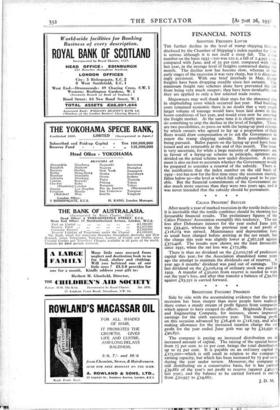FINANCIAL NOTES SHIPPING FREIGHTS LOWER
THE further decline in the level of tramp shipping freig,its disclosed by the Chamber of Shipping's index number for J Lily is serious although it is not itself a steep fall. The index number on the basis 1935 = too was 120.2, a fall of 2.4 per c compared with June, and of 35 per cent. compared with )uly last year, in the average level of freights contracted during the month. The decline now has become slow, whereas in the early stages of the recession it was very sharp, but it is disquiet- ingly persistent. With one brief interlude in May, tramp freights have been dropping steadily since last autumn. The minimum freight rate schemes alone have prevented the fall from being very much steeper; they have been invaluable, but they are applied to only a few selected trade routes.
Shipowners may well thank their stars for the abnormal rise in shipbuilding costs which occurred last year. Had building costs remained economic there is no doubt that a very much larger volume of tonnage would have been laid down in the boom conditions of last year, and would even now be entering the freight market. At the same time it is clearly necessary to do something to stop the decline in the level of freights. There are two possibilities, to press on with the laying-up pool scheme by which owners who agreed to lay up a proportion of their fleets would draw compensation or to ask the Government to renew the tramp shipping subsidy. Both possibilities are being pursued. Ballot papers on the laying up pool have been issued and are returnable at the end of this month. The issue is very uncertain, for while a large majority of shipowners are in favour of a laying-up scheme in principle, opinions are divided on the actual scheme now under discussion. A move- ment is also on foot to ascertain whether the Government would be prepared to consider a renewal of the subsidy. There is the justification that the index number on the old basis of 1929= too has now for the first time since the recession started, fallen below 92—the level at which full subsidy used to be pay. able. But the financial commitments of the Government are also much more onerous than they were two years ago, and it was never intended that the subsidy should be permanent.
CALICO PRINTERS' RESULTS
After nearly a year of marked recession in the textile industries it is inevitable that the textile combines should be showing less favourable financial results. The preliminary figures of the Calico Printers' Association exemplify this tendency. The net loss after Debenture interest for the year ended June 30th was £93,452, whereas in the previous year a net profit of £116,174 was earned. Maintenance and depreciation have as usual been charged before arriving at the net result, but the charge this year was slightly lower at £367,228 against £372428. The results now shown are the least favourable since 1931, when the net loss was £175,289.
There is thus no dividend on the £2,010,736 of preference capital this year, for the Association abandoned some years ago the attempt to maintain the dividends out of reserves. A year ago 6 months' dividend was paid out of earnings. The last dividend on the £3,016,104 of ordinary stock was paid in 1929. A transfer of £50,000 from reserve is needed to wipe out the year's loss, and after that transfer a balance of £39,809 against £83,351 is carried forward.
BRIGHTSIDE FOUNDRY PROGRESS Side by side with the accumulating evidence that the trade recession has been steeper than most people have realised, there comes a steady stream of profit figures from companies which appear to have escaped its effects. Brightside Foundry and Engineering Company, for instance, shows improved earnings for the sixth successive year. The trading profit on this occasion advanced by £28,406 to £118,193, and after making allowance for the increased taxation charge the net profit for the year ended June 30th was up by £22,930 at £903851.
The company is paying an increased distribution on an increased amount of capital. The raising of the special bonus from 7i per cent. to to per cent. brings the total distribution up to 25 per cent. It is payable on an ordinary capital of £175,000—which is still small in relation to the company's earning capacity, but which has been increased by 75 per cent. during the year under review. Moreover, the company is still distributing on a conservative basis, for it has carried £39,881 of the year's net profit to reserve (against ‘40,0,Do last year), and the balance to be carried forward is raised from £20,957 to £24,667.
J. D. M.


































 Previous page
Previous page